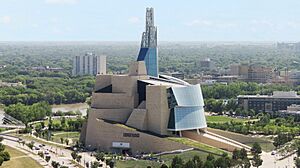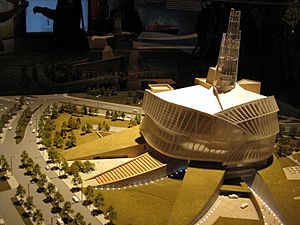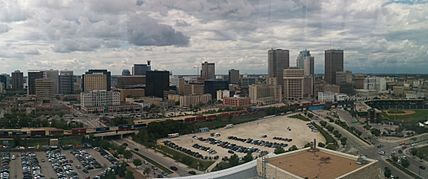Canadian Museum for Human Rights facts for kids
| Musée canadien pour les droits de la personne | |
 |
|

Canadian Museum for Human Rights in 2014
|
|
| Established | 13 March 2008 |
|---|---|
| Location | The Forks, Winnipeg, Manitoba, Canada |
| Type | Human rights museum |
| Visitors | 295,300 (2016/17) |
| Founder | Israel Asper and The Asper Foundation |
| Owner | Government of Canada |
|
Building details
|
|
| General information | |
| Groundbreaking | 19 December 2008 |
| Construction started | 2009 |
| Cost | $351 million |
| Height | |
| Observatory | 100 m (328.08 ft) |
| Technical details | |
| Material | alabaster, basalt rock, glass, Tyndall limestone, steel |
| Floor count | 8 |
| Floor area | 24,155 m2 (5.97 acres) |
| Lifts/elevators | 2 |
| Design and construction | |
| Architect | Antoine Predock |
| Awards and prizes | 14 national & international awards related to its architecture and construction |
| Other information | |
| Number of restaurants | 1 (ERA Bistro) |
| Agency overview | |
| Type | Crown corporation |
| Minister responsible |
|
| Key document |
|
The Canadian Museum for Human Rights (CMHR; French: Musée canadien pour les droits de la personne) is a Canadian Crown corporation and national museum located in Winnipeg, Manitoba, adjacent to The Forks. The purpose of the museum is to "explore the subject of human rights with a special but not exclusive reference to Canada, to enhance the public's understanding of human rights, to promote respect for others and to encourage reflection and dialogue."
Established in 2008 through the enactment of Bill C-42, an amendment of The Museums Act of Canada, the CMHR is the first new national museum created in Canada since 1967, and it is Canada's first national museum ever to be located outside the National Capital Region. The Museum held its opening ceremonies on 19 September 2014.
The Friends of the Canadian Museum for Human Rights is the charitable organization responsible for attracting and maintaining all forms of philanthropic contributions to the Museum.
Contents
History
Development
The late Izzy Asper—a Canadian lawyer, politician, and founder of the now-defunct media conglomerate Canwest Global Communications—is credited with the idea and vision to establish the CMHR, having first come up with the idea on 18 July 2000 to build the museum. Asper hoped it would become a place where students from across Canada could come to learn about human rights. He also saw it as an opportunity to revitalize downtown Winnipeg and increase tourism to the city, as well as to raise understanding and awareness of human rights, promote respect for others, and encourage reflection, dialogue, and action. Working on his idea for three years, Asper had a thorough feasibility study conducted by museum experts from around Canada.
In 2003, Asper established the Friends of the Canadian Museum for Human Rights, a private charitable organization, to build the CMHR. On 17 April, the 21st anniversary of Canada's Charter of Rights and Freedoms, an event was held at The Forks in Winnipeg where Asper first publicly announced the intent to create the CMHR. It was announced as a joint partnership between The Asper Foundation and the governments of Canada, Manitoba, and of Winnipeg, as well as land donated by the Forks Renewal Corporation. Prime Minister Jean Chrétien committed the first $30 million towards the capital cost, and private fundraising was soon overseen by the Friends of the CMHR. The Asper Foundation donated $20 million.
Later that year, on 7 October, Izzy Asper died suddenly at the age of 71 on his way to announce the architectural competition in Vancouver for the CMHR's design. Vowing to continue to develop the museum, his family and The Asper Foundation continued with the project, now spearheaded by Izzy's daughter, Gail Asper. Two weeks later, the symbolic sod-turning ceremony was held at The Forks and the architectural competition announced.
The Friends of the Canadian Museum for Human Rights launched the international architectural competition for the design of the CMHR, one of Canada's largest‐ever juried architectural competitions. 100 submissions from 21 countries worldwide were submitted. The judging panel chose the design submitted by Antoine Predock, an architect from Albuquerque, New Mexico. Meanwhile, Ralph Appelbaum, head of Ralph Appelbaum Associates, the world's largest museum design company, was hired to develop the CMHR's exhibits.
Legislation, construction, and opening
On 20 April 2007, Prime Minister Stephen Harper announced the Government of Canada's intention to make the CMHR into a national museum. On 13 March 2008, Bill C-42, An Act to amend the Museums Act and to make consequential amendments to other Acts, received royal assent in Parliament with support from all political parties, creating the Canadian Museum for Human Rights as a national museum.
By the middle of 2008, a government-funded opinion research project had been completed by the TNS/The Antima Group. The ensuing report—based primarily on focus group participants—listed the following: topics that the CMHR might cover (not in order of preference); key milestones in human rights achievements, both in Canada and throughout the world; current debates about human rights; and events where Canada showed a betrayal or a commitment to human rights.
Before construction could begin, archeologists, in consultation with Elders, conduct an extensive excavation and recovered over 400,000 artifacts in the ancestral lands.
The groundbreaking ceremony was held at the site of the CMHR on 19 December 2008, and official construction on the site began in April the following year. (Construction was initially expected to be completed in 2012.) The chair of the board resigned before his term was up, and a new interim chair was appointed.
On 3 July 2010, Queen Elizabeth II—having personally selected a stone from Runnymede, the English meadow where the Magna Carta was sealed in 1215—unveiled the Museum's cornerstone, inscribed with a message from the Queen and encased in Manitoba Tyndall stone.
The last of the 1,669 custom‐cut pieces of glass was installed in September 2012, and within a few months the base building was completed. The Museum's inauguration took place in 2014. Also in 2014, a stretch of road in front of the CMHR was named Israel Asper Way.
The museum's official grand opening on 20 September 2014 was protested by several activist groups, who expressed the view that their own human rights histories had been inaccurately depicted or excluded from the museum. The First Nations musical group A Tribe Called Red, who had been scheduled to perform at the opening ceremony, pulled out in protest against the museum's coverage of First Nations issues.
Funding
Funding for the capital costs of the CMHR is coming from three jurisdictions of government, the federal Crown, the provincial Crown, and the City of Winnipeg, as well as private donations. The total budget for the building of the exterior of the CMHR and its contents was $310 million as of February 2011. At the time of its opening in September 2014, the cost of the museum was approximately $351 million.
To date, the Government of Canada has allocated $100 million; the Government of Manitoba has donated $40 million; and the City of Winnipeg has donated $20 million. The Friends of the Canadian Museum for Human Rights, led by Gail Asper, have raised more than $130 million in private donations from across Canada toward a final goal of $150 million. These private-sector pledges include $4.5 million from provincial crown corporations in Manitoba and $5 million from the Government of Ontario. The Canadian Museum for Human Rights has requested an additional $35 million in capital funding from the federal government to cover shortfalls. In April 2011, the CMHR received an additional $3.6 million from the City of Winnipeg, which was taken from a federal grant to the city in lieu of taxes for the museum.
The CMHR's operating budget is provided by the government of Canada, as the CMHR is a national museum. The estimated operating costs to the federal government are $22 million annually. In December 2011, the CMHR announced that due to rising costs for the interior exhibits of the museum, the total construction cost had increased by an additional $41 million to a new total of $351 million. In July 2012, the federal and provincial governments agreed to further enhance the capital funding to the CMHR by up to $70 million, through a combination of a federal loan and a provincial loan guarantee. This newest funding was essential for the completion of the interior exhibits so that the museum could officially open in 2014, already two years behind schedule.
Architecture
The building's ground floor provides orientation and meeting space, a gift shop, restaurant, and visitor services. Galleries on different levels are linked by dramatic backlit alabaster ramps, including the Hall of Hope. There is also a Garden of Contemplation, which has still-water pools punctuated by dramatic black Mongolian basalt.
Beginning with the Great Hall, the visitor experience culminates in the Israel Asper Tower of Hope, a 100-metre glass spire protruding from the CMHR that provides visitors with views of downtown Winnipeg.
Design and construction process
In 2003, the Friends of the Canadian Museum for Human Rights launched an international architectural competition for the design of the CMHR. 100 submissions from 21 countries worldwide were submitted. The judging panel chose the design submitted by Antoine Predock from Albuquerque, New Mexico.
His vision for the CMHR was a journey, beginning with a descent into the earth where visitors enter the CMHR through the "roots" of the museum. Visitors are led through the Great Hall, then a series of vast spaces and ramps, before culminating in the "Tower of Hope", a tall spire protruding from the CMHR. He has been quoted as saying: "I'm often asked what my favorite, my most important building is.... I'm going on record right now... 'This is it.'"
Predock's inspiration for the CMHR came from the natural scenery and open spaces in Canada, including trees, ice, northern lights, First Nations peoples in Canada, and the rootedness of human rights action. He describes the CMHR in the following way:
The Canadian Museum for Human Rights is rooted in humanity, making visible in the architecture the fundamental commonality of humankind-a symbolic apparition of ice, clouds and stone set in a field of sweet grass. Carved into the earth and dissolving into the sky on the Winnipeg horizon, the abstract ephemeral wings of a white dove embrace a mythic stone mountain of 450 million year old Tyndall limestone in the creation of a unifying and timeless landmark for all nations and cultures of the world.
The base building was complete since the end of 2012. Throughout the foundation work of the CMHR, medicine bags created by elders at Thunderbird House, in Winnipeg, were inserted into the holes made for piles and caissons to show respect for Mother Earth. The CMHR website had two webcams available for the public to watch the construction as it progressed.
For the construction of the Hall of Hope, full of illuminated alabaster ramps, more than 3.500m² and 15.000 tiles of alabaster were used, making it the biggest project ever done with alabaster.
On 3 July 2010, Elizabeth II, Queen of Canada, unveiled the building's cornerstone. The stone bears the Queen's royal cypher and has embedded in it a piece of stone from the ruins of St. Mary's Priory, at Runnymede, England, where it is believed the Magna Carta was approved in 1215 by King John.
Exhibition and facilities
On the fifth floor is the Carte International Reference Centre, the CMHR library "devoted to collecting and providing access to resources that support human rights learning and research."
Exhibit design
The CMHR worked with exhibit designer Ralph Appelbaum Associates (RAA) from New York to develop the inaugural exhibits of the museum. RAA indicated that the galleries throughout the CMHR would deal with various themes including the Canadian human rights journey, Indigenous concepts of human rights, the Holocaust, and current human rights issues. The CMHR's team of researchers worked with RAA to develop the inaugural exhibits.
In January 2009, lawyer Yude Henteleff was appointed to chair the museum's content advisory committee, made up of human rights experts and leaders from across Canada. The committee was a key part of the museum's first large-scale public engagement exercise. Through a cross-country tour from May 2009 to February 2010 called "Help Write the Story of the Canadian Museum for Human Rights", CMHR researchers visited 19 cities and talked to thousands of people about their human rights experiences and what they wanted to see in the museum. This consultation process was led by Lord Cultural Resources, based in Toronto. On 5 March 2013, a story produced by CBC TV (Manitoba) mentioned a document, "Gallery Profiles" (dated 12 September 2012), that confirmed some of the CMHR's proposed contents. The museum's largest gallery is dedicated to Canadian content, while a thematic approach is taken throughout all of its galleries.
Galleries
The museum has had 10 core galleries since the time of its opening in September 2014:
- What are human rights?
- Indigenous perspectives.
- This includes a "circular movie about First Nations concepts of rights and responsibilities to each other and the land." Curator Lee-Ann Martin described contemporary installation artist Rebecca Belmore's "Trace", a 2+1⁄2-storey "ceramic blanket" commissioned by the CMHR. This blanket is part of a series by Winnipeg-based Anishinaabe artist Belmore that "expose the traumatic history and ongoing violence against Aboriginal people."
- Canadian journeys.
- This includes "prominent exhibits" on residential schools, "missing and murdered aboriginal women", "forced relocation of Inuit". as well as Japanese during World War II, disabilities from Ryerson University, Chinese head tax, the Underground Railroad, Komagata Maru and the Winnipeg General Strike.
- Protecting rights in Canada
- Examining the Holocaust and other genocides.
- The gallery on genocide includes the five genocides recognized by Canada: the Holocaust, the Holodomor, the Armenian genocide, the Rwandan genocide and the Bosnian ethnic cleansing.
- Turning points for humanity
- Breaking the silence
- Actions count
- Rights today
- Inspiring change
Indigenous issues are addressed in each gallery, but are prominent in the " Canadian Journeys Gallery" and the "Indigenous Perspectives Gallery".
Partnerships
Several agreements have been reached by the CMHR and various educational institutions and government agencies, to enhance the quality and depth of information provided by the museum, as well as to broaden the educational opportunities for the museum. This is a tentative and evolving list of organizations that have partnered with the museum:
- University of Manitoba
- University of Winnipeg
- National Museum – "Memorial to Holodomor victims" (Kyiv, Ukraine)
- Canadian Association of Statutory Human Rights Agencies
- Ambassador of the Kingdom of the Netherlands to Canada (Netherlands Embassy)
- Library and Archives Canada
- The Manitoba Museum
- Manitoba Education (the Province of Manitoba)
See also





